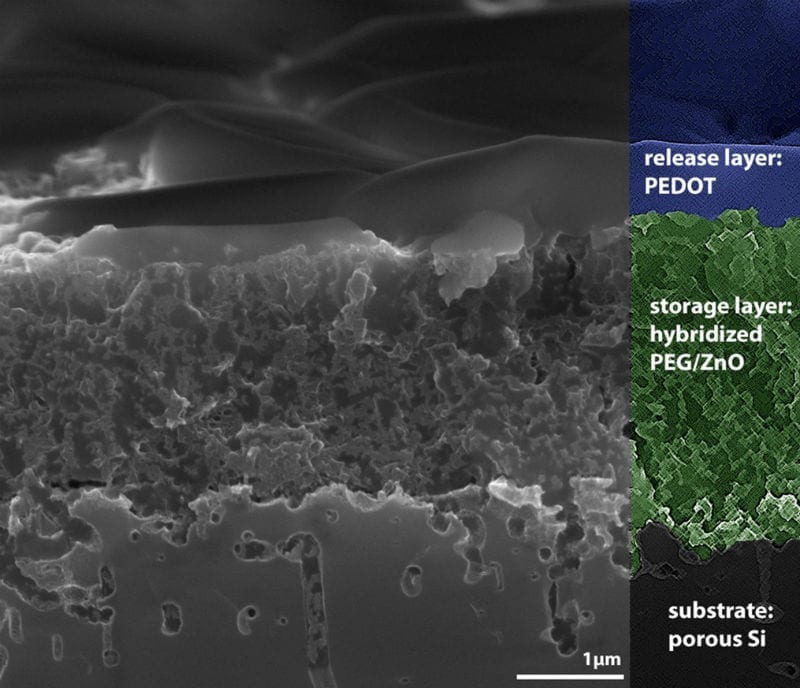Scientists at ETH Zurich and an ETH spin-off have developed a novel polymer for coating materials, in order to prevent biofilms from forming on their surfaces.
Thanks to the technological platform developed, it is now possible to coat durably a variety of different materials using the same polymeric molecule. Such coatings are of relevance for medical applications, among others.
Internal and external qualities are two different things – the same holds true in materials science. For example, in many cases a specific material would, in principle, be ideal for a technical application were it not for the fact that its surface is unsuitable.
Materials scientists solve this problem by coating the material. Coatings can be used to make a surface lubricious, for example, or – in underwater applications or the biomedical sector – to prevent algae, proteins or bacteria from fouling the surface over time. For example, hydrophilic polymers are often used to protect metals from fouling; water molecules accumulate on this polymer layer, which protects the metal against the adhesion of unwanted molecules or organisms. However, many coatings currently in use are not very resistant to environmental factors, since they are often connected to the material by only a weak electrostatic bond. Other existing, more resistant coatings are expensive to use and sometimes require toxic solvents.
Strong bonds to a wide range of materials
Scientists led by Nicholas Spencer, Professor of Surface Science and Technology, and researchers at the ETH spin-off Susos thus searched for a simple solution to binding coating molecules to surfaces with a strong chemical bond, known as a covalent bond. They also wanted to find a solution that could be used to coat a range of surfaces and devices composed of several different materials. “We wanted a polymer coating that is as versatile as a Swiss army knife,” says Spencer.
And that is just what the scientists succeeded in developing. The molecule has a long backbone from which hydrophilic side chains branch out and impart the non-fouling properties. The polymer also has two types of side chains for covalent bonding to metals – one for binding to silicon and glass, the other for binding to oxides of what are known as transition metals, which include titanium and iron.
Dip and rinse
“Coatings with our new polymer are very simple. It’s just dip and rinse”, says Spencer. “And the coating withstands even harsh conditions such as acids, alkalis, high salt concentrations and detergents.”
The ETH spin-off Susos has submitted a patent application for the polymer. The scientists see possible applications mainly in biomedical diagnostics and medical technology, such as in biosensors, implants and future implantable drug-delivery systems. Other applications could include biofouling prevention in water treatment, ship transport, and fishing, as well as the food industry, for example in packaging.
The “Swiss army knife” in its current form is highly adaptable and opens the door to a host of further developments. As Spencer explains, it would be possible to equip the polymer’s molecular backbone with side chains that bind to other materials, or to replace the side chains that prevent biofilm adhesion with others that have totally different properties.
Learn more: “Swiss army knife” molecule
The Latest on: Polymer coating
[google_news title=”” keyword=”polymer coating” num_posts=”10″ blurb_length=”0″ show_thumb=”left”]
via Google News
The Latest on: Polymer coating
- Traffic Road Marking Coatings Market Poised to Reach US$ 9.34 Billion by 2032, Fueled by Innovations in Reflectivity and Durabilityon April 26, 2024 at 8:07 am
The global traffic road marking coatings market sales are expected to reach a market valuation of US$ 5.22 Billion by the year 2022, accelerating with a moderate CAGR of 6% by 2022-2032. The Traffic ...
- Growing Demand from Electrical and Electronics Sectors Propels Conductive Polymer Coatings Market Amidst Cost Challengeson April 23, 2024 at 8:46 am
The conductive polymer coatings market is projected to grow at an impressive pace with a CAGR of 9.3% during 2022-2032. Widespread use of conductive polymer coatings for corrosion protection and ...
- Innovative nanocoating shown to significantly enhance battery casing fire resistanceon April 23, 2024 at 1:58 am
Science X is a network of high quality websites with most complete and comprehensive daily coverage of the full sweep of science, technology, and medicine news ...
- Polymer Coated Fabrics Market Trends, Size, Share, Growth Status, Key Segments and Forecast to 2024 to 2032on April 18, 2024 at 3:23 pm
Polymer Coated Fabrics Market is valued approximately USD $ billion in 2021 and is anticipated to grow with a healthy growth rate of more than $ over the forecast period 2022-2028. Polymer coated ...
- Polymer Coated Fabrics Market Trends, Business Growth and Major Driving Factors 2032on April 18, 2024 at 3:03 pm
Polymer Coated Fabrics Market is valued approximately USD $ billion in 2021 and is anticipated to grow with a healthy growth rate of more than $ over the forecast period 2022-2028. Polymer coated ...
- Polymer overlay coating on Milwaukee St bridge in Janesville needs replacementon April 17, 2024 at 3:51 pm
Despite opening in December of 2019, a bridge in Janesville is looking a little worse for wear. Motorists traveling over the Milwaukee Street bridge in Janesville may have noticed what looks like sect ...
- New plastic coating discovery gives greater functionality to 3D printingon April 17, 2024 at 8:08 am
Scientists and engineers have developed a new coating for plastic particles that are used in 3D printing, which significantly increases their functionality and opens up new possibilities for ...
- New plastic coating discovery gives greater functionality to 3D printingon April 16, 2024 at 5:01 pm
To tackle some of these challenges we have created a simple but effective approach to adding functionality by coating the particles. We've designed the colored shell polymer so that it matches the ...
via Bing News








